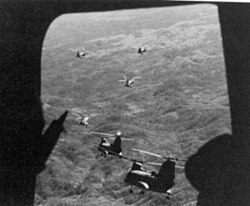Operation Dewey Canyon
| Operation Dewey Canyon | |||||||
|---|---|---|---|---|---|---|---|
| Part of the Vietnam War | |||||||
 |
|||||||
|
|||||||
| Belligerents | |||||||
|
|
|
||||||
| Commanders and leaders | |||||||
| Robert H. Barrow | Unknown | ||||||
| Strength | |||||||
|
9th Marine Regiment: 2,200 Marines+ 2nd Battalion, 12th Marines |
Elements of the 9th NVA Regiment~ 5,000 | ||||||
| Casualties and losses | |||||||
| 130 killed, 932 wounded (USMC account) |
1,617 killed, unknown number wounded (USMC account) |
||||||
Operation Dewey Canyon was the last major offensive by the United States Marine Corps during the Vietnam War. It took place from January 22 through March 18, 1969 and involved a sweep of the People's Army of Vietnam (PAVN)-dominated A Shau and Song Đa Krông Valleys by the 9th Marine Regiment. Based on intelligence and captured documents, the NVA unit in contact was believed to be the 9th NVA Regiment.
The 56 days of combat were a tactical success but did not stop the overall flow of North Vietnamese men and matériel into South Vietnam. The 9th Marine Regiment and attached units were awarded the Army Presidential Unit Citation for their actions in Operation Dewey Canyon.
Throughout 1967 and into 1968, United States Marine Corps units in the northern I Corps region had been tied to their combat bases along the South Vietnam border as part of the McNamara Line. This "line" was a combination of infantry units and ground sensors devised to stop North Vietnamese infiltration into South Vietnam along the Ho Chi Minh Trail. When Lt. Gen. Raymond G. Davis took command of the 3rd Marine Division, he ordered Marine units to move out of their combat bases and engage the enemy. He had noted that the manning of the bases and the defensive posture they developed was contrary to the aggressive style of fighting that Marines favor.
In early 1969, intelligence reports indicated there had been a large PAVN build-up in the A Shau and Đa Krông Valleys. The A Shau was just 10 km east of the Laotian border and some 34 km long, while the Đa Krông was several kilometers further east and separated by two mountain ranges.
...
Wikipedia
